AMD Radeon HD 7950 Review Feat. Sapphire & XFX: Sewing Up The High-End Market
by Ryan Smith on January 31, 2012 9:02 AM ESTCrysis: Warhead
Kicking things off as always is Crysis: Warhead. It’s no longer the toughest game in our benchmark suite, but it’s still a technically complex game that has proven to be a very consistent benchmark. Thus even 4 years since the release of the original Crysis, “but can it run Crysis?” is still an important question, and the answer continues to be “no.” While we’re closer than ever, full Enthusiast settings at a 60fps is still beyond the grasp of a single-GPU card.
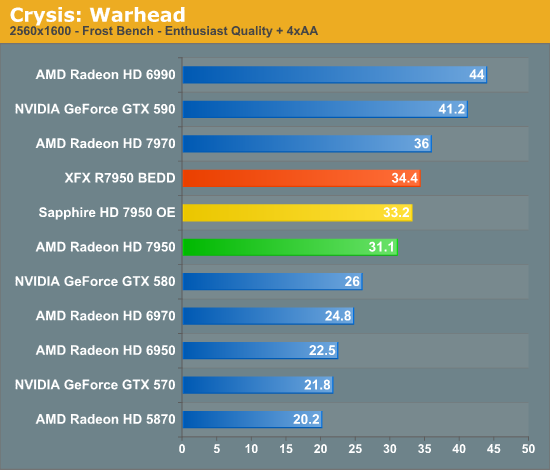
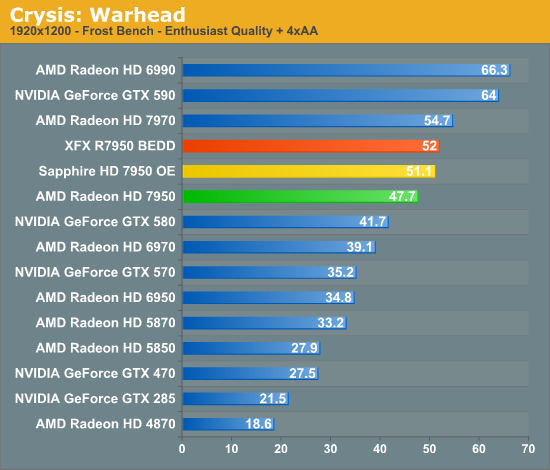
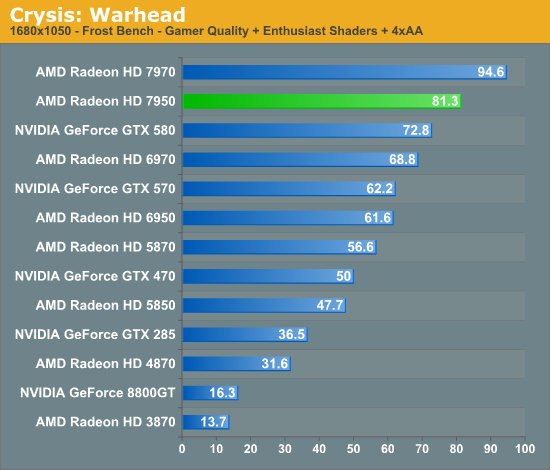
AMD’s first round of driver optimizations have given the 7900 a very solid footing in Crysis, putting the 7950 off to a great start. The 7950 is 19% ahead of the GTX 580 at 2560 and 14% ahead at 1920, putting the card in a comfortable position that for single-GPU cards is second only to the 7970. In spite of Crysis being shader-bound most of the time the 7950 is generally within 15% of the 7970, so it’s doing better than the theoretical performance gap between the two cards would predict. Meanwhile compared to AMD’s last generation offerings it’s not much of a contest: the 7950 is 20-25% ahead.
As for our factory overclocked Sapphire and XFX cards, they further close the gap between the 7950 and 7970. The 12.5% core overclock on these cards puts them between 7% and 10% faster than the stock clocked 7950, with the XFX card edging out the Sapphire due to its memory overclock. These cards do so well here than the reference 7970’s lead is reduced to just 5%.
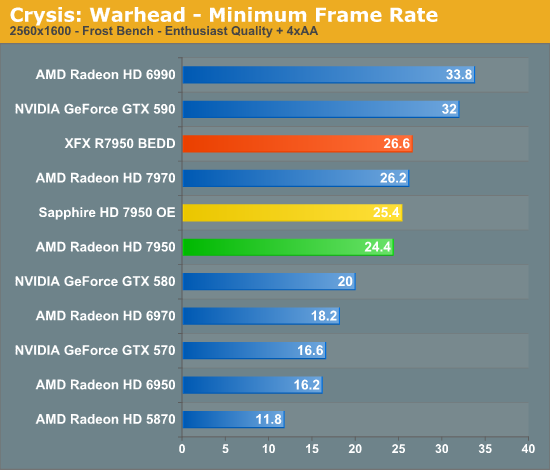

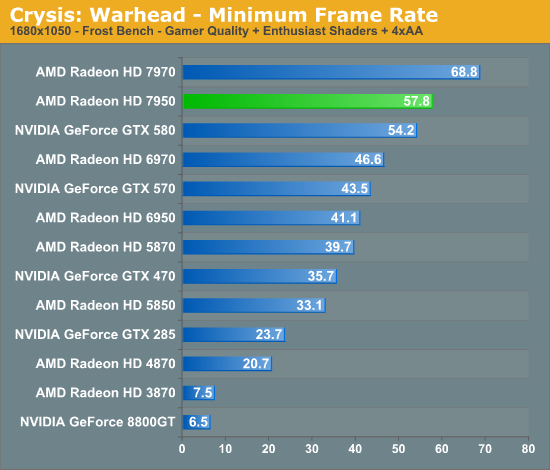
The minimum framerates in Crysis are also looking good on the 7950, with the 7950 turning in a 10-22% better minimum framerate than the GTX 580 depending on whether we’re talking about 1920 or 2560. As like we saw with the 7970, the biggest lead is at the highest resolutions, which has typically been the case for AMD cards for some time now. The overclocked partner cards add to this, tacking on an extra 5-10% in performance.










259 Comments
View All Comments
Shadowmaster625 - Tuesday, January 31, 2012 - link
Well some of us do care about noise and power consumption. That sapphire card runs very cool and quiet, nearly silent in fact. It uses 30 less watts at typical idle and nearly 100 watts less than a 580 while gaming. That's about a penny per hour of gaming. Power savings could easily reach $40 over two years of gaming, plus another $30 if you leave your pc on 24/7, for a total of $70 saved over two years.Thats is about what one year of technological advancement is worth.
SlyNine - Tuesday, January 31, 2012 - link
Because in part the 480/580 are dogs in regards to power consumption. My 5870 idles at nearly the same and only uses a bit more under load. It is also 2 1/2 years older.AssBall - Tuesday, January 31, 2012 - link
You do realize that the parts you have "execs jumping out of windows" about account for maybe 1/200th of the companies income? Guess not.chizow - Tuesday, January 31, 2012 - link
Actually I think these parts will make up an overwhelming % of the company's income given their graphics division is one of the few within AMD that consistently turns a profit. But I guess I actually know what "income" is and how its calculated. Given these parts sell for 50% higher price than any single-ASIC SKU (CPU or GPU) in the last 5 years, I think there's a good chance these parts will make up the bulk of their profit for the quarter.You really think AMD is turning some amazing profit on their free AR Bulldozer promos or happy meal priced APUs when they struggle to make a profit on a quarterly basis? There's break-even (90-95% of their revenue) and then there's parts like this that actually sell for a profit. They don't need to sell high volume on these parts when the ASP and margins are so healthy.
repoman27 - Tuesday, January 31, 2012 - link
Actually, you should try reading AMD's Q4 earnings report which was just posted here: http://www.anandtech.com/show/5465/amd-q411-fy-201...The graphics division only accounted for 8.4% of AMD's operating income for fiscal 2011, if you ignore the accounting monkey business regarding GloFo.
Of that 8.4%, about half is likely attributable to FirePro because the gross margins for professional and compute solutions are easily double that of consumer GPUs.
While the ASP's and gross margins on enthusiast cards are great compared to the high volume consumer stuff, they still represent a niche market, and realistically less than 3% of AMD's 2011 operating income.
chizow - Wednesday, February 1, 2012 - link
I have read it and it obviously doesn't include any significant Tahiti or 28nm parts, since they only started to ship the first few units for revenue for that Jan 7th 7970 launch.As stated in the article:
"while the first true 7000 series part (Tahiti) did not launch until 2012 and only started shipping for revenue very late into 2011. Still, it was enough to have a significant impact on AMD’s GPU ASP, increasing it over 2010’s ASP even with the limited number of new products."
Obviously projected revenue will be much higher with a full quarter at these prices.
But yes the rest of your post confirms my point, if you want to point to FirePro I can already guarantee you they will sell more 7970 consumer desktop parts than any FirePro parts using the same ASIC, we're not talking about Quadro here lol.
At $450-600, that's already a HUGE markup and increase in their gross margins compared to any previous single-ASIC desktop SKU, so its obviously going to result in a huge increase in profits.
And no you can't just discount that "GloFo" business, if the rest of the company loses money because of poor supplier/pricing decisions and selling prices and the other consistently makes money and represents the bulk of the company's income.
repoman27 - Wednesday, February 1, 2012 - link
Seriously, put down the crack pipe.Have you ever looked at the relative prices of consumer desktop parts vs. FirePro parts based on the same chip? Yes, they will sell a lot more of the consumer parts, and yet they will still make more profit on the fewer FirePro parts sold. So when AMD wholesales chips to partners so the partners can produce cards that end up retailing for $450-600, you believe their gross margins are higher than when they sell a FirePro V9800 directly to a retailer who turns around and sells it for $2800?
Why are you so convinced that the difference in retail release prices for the 7 series and 6 series is solely attributable to AMD expanding their gross margin? The 7 series is being offered for 50% more than the 6 series was, and yet the transistor count increased by over 62%. Not to mention that these are the first parts produced on the new 28nm node, so yields are probably less than stellar at this point, despite what TSMC might have us believe.
Furthermore, the GloFo business is germane to both the CPU and GPU divisions. Graphics accounted for less than a quarter of AMD's overall revenue for 2011 and only 8.4% of their income, no matter how you want to look at it. All I omitted was the one time charges that AMD took for the decrease in value of their stake in GloFo and the costs associated with their corporate restructuring.
No matter what you believe, 8.4 is a larger number than 91.6. Hang it up, you're flat out wrong.
chizow - Thursday, February 2, 2012 - link
No, you need to put down the "crack pipe."You're using past performance to define FUTURE revenue forecasts, which is what my statement was about. That's the whole point, the GPU division WAS disappointing in 2011, but ASP and profit increased year over year in Q4 based on the high ASP of the few Tahiti parts that shipped in December.
Obviously Tahiti parts will have a bigger impact on both numbers in Q1 '12 with a full 3 quarters and volume shipment at these high ASPs which is exactly what I stated.
As for why I think the difference in 7 and 6 series pricing was the difference in segment margins? Because I know how to read financial statements and MD&A. 11/12 months with DECLINING revenue and margins selling only 6 series and specifically cited by AMD caused by declining sales and ASP on their desktop and shortages of their Llano mobile parts. Then in Q4, despite declining revenue sequentially and y2y, their ASP, margins and profit increases. Do you think this is a result of their 6 series which spent the whole year declining in sales and margin, or the 7 series that sell for 50-100% more than their previous products? Hmmm.....
Now what do you think is going to happen with a full 3 quarters at the same prices for the graphics division? What do you think is going to happen to the company's financials given they are predicting a gloomy outlook with predicted 8% decrease in revenue sequentially? I can already guarantee you the graphics division will be profitable, maybe ~$100M, but the CPU division will at best break even if they don't post a loss. Which brings us full circle to the comment you and others apparently had issue with:
Actually I think these parts will make up an overwhelming % of the company's income given their graphics division is one of the few within AMD that consistently turns a profit.
repoman27 - Wednesday, February 1, 2012 - link
And clearly I meant to say that 8.4 is NOT a larger number than 91.6.Sunburn74 - Tuesday, January 31, 2012 - link
I think the power.consumption reductions are quite significant and eventually may be passed onto the mobile space.